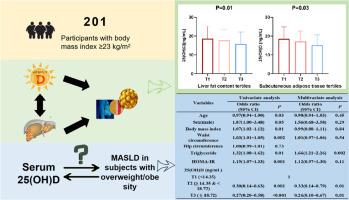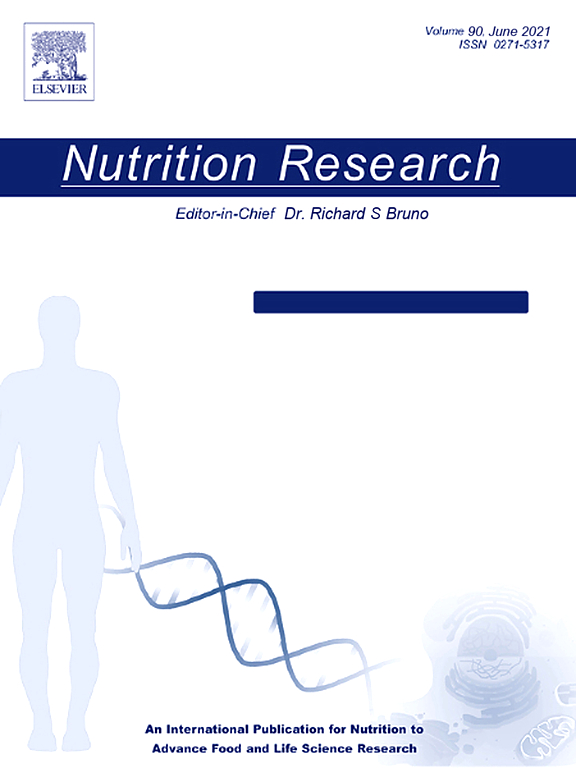低血清25羟维生素D与超重/肥胖患者严重代谢功能障碍相关的脂肪变性肝病相关:一项横断面研究
IF 3.1
3区 医学
Q2 NUTRITION & DIETETICS
引用次数: 0
摘要
维生素D在代谢功能障碍相关脂肪变性肝病(MASLD)中的作用仍然存在争议。此外,评估维生素D水平与腹部脂肪分布之间关系的研究有限。因此,我们假设在超重/肥胖人群中,血清维生素D与肝脏脂肪含量(LFC)的严重程度呈负相关。201名体重指数≥23 kg/m2的受试者按25羟维生素D (25 (OH) D)浓度分为维生素D缺乏症(≤20 ng/mL)和维生素D正常(≥20 ng/mL)两组。磁共振成像-质子密度脂肪分数用于测量肝脏、胰腺、腹部、皮下和内脏的脂肪堆积。维生素D缺乏组的LFC和皮下脂肪组织(SAT)明显高于正常维生素D组(P < 0.05)。然而,两组之间内脏脂肪组织和胰腺脂肪含量无显著差异。此外,随着超重/肥胖个体LFC和SAT严重程度的增加,血清25 (OH) D浓度显著降低(P < 0.05)。进一步的多变量调整logistic回归分析显示,暴露于25 (OH) D水平最高的个体比暴露于25 (OH) D水平最低的个体发生严重肝脂肪变性的风险更低(T3 vs. T1, OR 0.26, 95% CI 0.10-0.67, P = 0.01)。我们的研究结果表明,在超重/肥胖个体中,血清25 (OH) D浓度与严重MASLD之间存在显著的负相关。需要进一步的研究来探索这种关联背后的代谢机制及其对肝脏保护的影响。本文章由计算机程序翻译,如有差异,请以英文原文为准。

Low serum 25 hydroxyvitamin D Is associated with severe metabolic dysfunction-associated steatotic liver disease in individuals with overweight/obesity: A cross-sectional study
The role of vitamin D status in metabolic dysfunction-associated steatotic liver disease (MASLD) remains controversial. Furthermore, research evaluating the relationship between vitamin D status and abdominal fat distribution is limited. Therefore, we hypothesized that serum vitamin D is inversely associated with the severity of liver fat content (LFC) in populations with overweight/obesity. A total of 201 subjects with body mass index ≥23 kg/m2 were classified by 25 hydroxyvitamin D (25 (OH) D) concentration as either vitamin D deficiency (<20 ng/mL) or vitamin D normal (≥20 ng/mL). Magnetic resonance imaging-proton density fat fraction was used to measure fat accumulation in the liver, pancreas, and abdomen subcutaneous and visceral. The LFC and subcutaneous adipose tissue (SAT) were significantly higher in the vitamin D deficient group compared to the normal vitamin D group (P < .05). However, there were no significant differences in visceral adipose tissue or pancreatic fat content between the 2 groups. Additionally, as the severity of LFC and SAT increases in individuals with overweight/obesity, serum 25 (OH) D concentration significantly decreases (P < .05). Further multivariate-adjusted logistic regression analysis revealed that individuals in the highest tertile of 25 (OH) D exposure exhibited lower risks of severe hepatic steatosis compared to those in the lowest tertile (T3 vs. T1, OR 0.26, 95% CI 0.10-0.67, P = .01). Our results identify a significant inverse association between serum 25 (OH) D concentration and severe MASLD in individuals with overweight/obesity. Further research is needed to explore the metabolic mechanisms underlying this association and their implications for liver protection.
求助全文
通过发布文献求助,成功后即可免费获取论文全文。
去求助
来源期刊

Nutrition Research
医学-营养学
CiteScore
7.60
自引率
2.20%
发文量
107
审稿时长
58 days
期刊介绍:
Nutrition Research publishes original research articles, communications, and reviews on basic and applied nutrition. The mission of Nutrition Research is to serve as the journal for global communication of nutrition and life sciences research on diet and health. The field of nutrition sciences includes, but is not limited to, the study of nutrients during growth, reproduction, aging, health, and disease.
Articles covering basic and applied research on all aspects of nutrition sciences are encouraged, including: nutritional biochemistry and metabolism; metabolomics, nutrient gene interactions; nutrient requirements for health; nutrition and disease; digestion and absorption; nutritional anthropology; epidemiology; the influence of socioeconomic and cultural factors on nutrition of the individual and the community; the impact of nutrient intake on disease response and behavior; the consequences of nutritional deficiency on growth and development, endocrine and nervous systems, and immunity; nutrition and gut microbiota; food intolerance and allergy; nutrient drug interactions; nutrition and aging; nutrition and cancer; obesity; diabetes; and intervention programs.
 求助内容:
求助内容: 应助结果提醒方式:
应助结果提醒方式:


